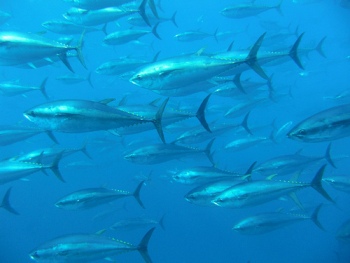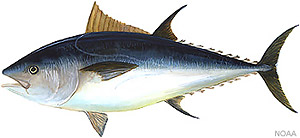
Anything you can do I can do Better
Thermal Adaptations
The Atlantic Bluefin tuna can maintain a high body temperature
because its muscles that are used for swimming are located at the
core of its body. These muscles generate heat when they are
used and act as internal heaters. Another adaptation is a
specialized circulatory system that keeps the core muscles
warm so they can function efficiently. The arteries branch out
from the body core toward the surface tissues. The heat from
 the
blood moving through the arteries warms the cooler blood coming back
in the veins near the surface. This prevents any cooling of
the essential core muscles.
the
blood moving through the arteries warms the cooler blood coming back
in the veins near the surface. This prevents any cooling of
the essential core muscles.
Coloration
Bluefin have opposite coloration which helps to camouflage them in the water and make it harder for predators to find them. They are dark blue on the dorsal side to blend in with the dark ocean below when seen from above. Their ventral sides are white so that they blend in with the light sky when seen from below.
Swimming Adaptations
Bluefin tuna have stream-lined bodies, with eyes that are flush with the head and retractable pectoral fins, which help reduce the amount of drag when swimming. They are negatively buoyant which means they will sink if they stop swimming. By using their pectoral fins like the wings of a plane, they generate lift. These pectoral fins are also used to maneuver when chasing prey. Bluefin have stiff bodies and do not bend when they swim like most fish. Their lunate-shaped tail is very efficient, and there are rows of finlets on the top and bottom of the posterior section of the tail which help reduce drag.
